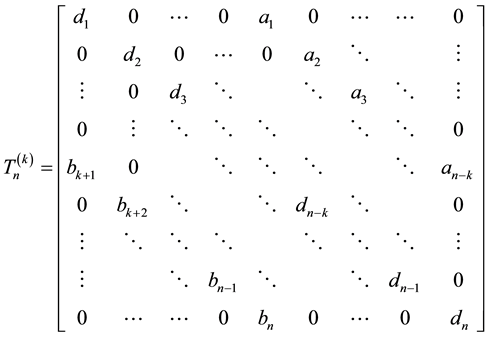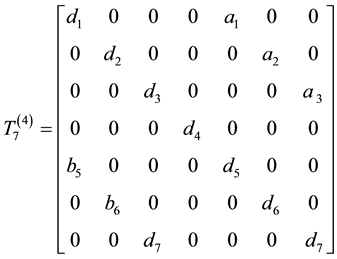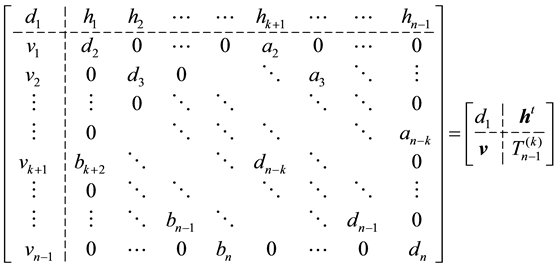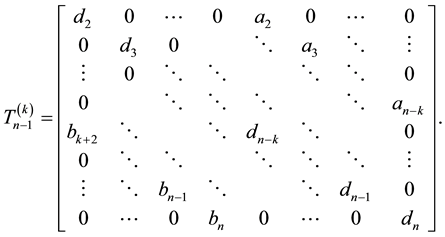Journal of Applied Mathematics and Physics
Vol.03 No.09(2015), Article ID:60020,7 pages
10.4236/jamp.2015.39147
A Generalized Symbolic Thomas Algorithm for Solving Doubly Bordered k-Tridiagonal Linear Systems
Nermeen Shehab1*, Moawwad El-Mikkawy2, Mohammed El-Shehawy1
1Mathematics Department, Faculty of Science, Damietta University, Damietta, Egypt
2Mathematics Department, Faculty of Science, Mansoura University, Mansoura, Egypt
Email: *nermeen_shehab87@yahoo.com, m_elmikkawy@yahoo.com, melshehawey@yahoo.com
Copyright © 2015 by authors and Scientific Research Publishing Inc.
This work is licensed under the Creative Commons Attribution International License (CC BY).
http://creativecommons.org/licenses/by/4.0/



Received 16 June 2015; accepted 26 September 2015; published 29 September 2015
ABSTRACT
In the current paper, the authors present a symbolic algorithm for solving doubly bordered k-tri- diagonal linear system having n equations and n unknowns. The proposed algorithm is derived by using partition together with UL factorization. The cost of the algorithm is O(n). The algorithm is implemented using the computer algebra system, MAPLE. Some illustrative examples are given.
Keywords:
Doubly Bordered k-Tridiagonal Matrix, UL Factorization, DETGDBTRI Algorithm, Thomas Algorithm, Computer Algebra Systems (CAS)

1. Introduction
The general tridiagonal matrixtakes the form:
 (1)
(1)
Such matrices arise in many applications, such as boundary value problems, parallel computing, telecommunication system analysis, interpolation with splines and solution of differential equations using finite differences. Research area on these types of matrices is very active and has recently attracted the attention of many researchers. The interested reader may refer to [1] -[4] .
Recently, researchers have begun considering the k-tridiagonal matrix as a generalization of the special matrixin (1).
The general k-tridiagonal matrix takes the form:
 (2)
(2)
For example,
 (3)
(3)
The importance of such matrices could be shown clearly in the last few years. For more details see, for instance, [5] -[8] .
In this paper, we are going to focus on the doubly bordered k-tridiagonal matrix, here after will be referred to as k-DBT, which has the form:
 (4)
(4)
We can hold the view that the above matrix is a natural extension of the k-tridiagonal matrix in (2).
In a partitioned form, the matrix
 in (4) can be written as:
in (4) can be written as:
 (5)
(5)
where

 and
and
 (6)
(6)
Throughout this paper, the word “simplify” means to simplify the algebraic expression under consideration to its simplest rational form. Also,
 is a formal parameter which can be treated as a symbolic name whose actual value is 0 as we will see later.
is a formal parameter which can be treated as a symbolic name whose actual value is 0 as we will see later.
The present paper is organized as follows. In the next section, numeric and symbolic algorithms for evaluating the k-DBT determinant are constructed. The UL factorization of doubly bordered k-tridiagonal matrix is also considered. Finally, the solution of the linear system whose coefficient matrix is of type k-DBT is proposed. In Section 4, some illustrative examples are given.
2. Generalization of the DETGDBTRI Algorithm
In order to factor the k-tridiagonal matrix in (6), it is advantageous to introduce the (n − 1) quantities associated with the matrix
 as follows:
as follows:
 (7)
(7)
Now, consider the following theorem whose proof will be omitted.
Theorem (1):
The Doolittle
 of the matrix
of the matrix
 takes the form:
takes the form:
 (8)
(8)
At this point, it should be mentioned that the above factorization in (8) is always possible even if the matrix
 is singular.
is singular.
Armed with the partitioned form of



where


By using the above equation, we see that the following four systems of equations are necessarily satisfied



and

Solving (10)-(12) for




and

where
We may now formulate the following algorithm for evaluating


As can be easily seen, Algorithm (2.1) breaks down if any ei = 0 for some

The Algorithm 2.2 will be referred to as k-DETGDBTRI algorithm. It is a natural extension of the DETGDBTRI algorithm presented in [11] .
3. Solving Linear System of Equations with Coefficient Matrix of Typek-DBT
In this section, we introduce a symbolic algorithm for solving k-DBT linear systems of the form:

where


The Algorithm (3.2) will be referred to as k-DBTLSys algorithm. The total computational cost of the k- DBTLSys algorithm is

A maple code based on algorithm 3.1 is available upon request from the authors.
The following four remarks are given in order:
Remark 1. If
Remark 2. If
Remark 3. If
Remark 4. If


4. Illustrative Examples
Notice that in the following examples, blank elements in the matrices are zeros.
Example 4.1. Consider the following k-DBT linear system:

Solution: In this example, we have n = 6 and k = 3.
Applying the k-DBTLSys algorithm gives:
・


・

・

・

・

The solution is
Example 4.2. Consider the following k-DBT linear system:

Solution: In this example, we have n = 10 and k = 5.
Applying the k-DBTLSys algorithm yields:
・

・

・

・

The solution is

Example 4.3. Consider the following k-DBT linear system:

Solution: In this example, we have n = 14 and k = 8.
Applying the k-DBTLSys algorithm gives:
・

・

・

・

・ The solution is

Cite this paper
NermeenShehab,MoawwadEl-Mikkawy,MohammedEl-Shehawy, (2015) A Generalized Symbolic Thomas Algorithm for Solving Doubly Bordered k-Tridiagonal Linear Systems. Journal of Applied Mathematics and Physics,03,1199-1206. doi: 10.4236/jamp.2015.39147
References
- 1. El-Mikkawy, M. (2003) A Note on a Three-Term Recurrencefor a Tridiagonal Matrix. Applied Mathematics and Computation, 139, 503-511.
http://dx.doi.org/10.1016/S0096-3003(02)00212-6 - 2. El-Mikkawy, M. (2004) On the Inverse of a General Tridiagonal Matrix. Applied Mathematics and Computation, 150, 669-679.
http://dx.doi.org/10.1016/S0096-3003(03)00298-4 - 3. El-Mikkawy, M. and Karawia, A. (2006) General Tridiagonal Matrices. Applied Mathematics Letters, 19, 712-720.
http://dx.doi.org/10.1016/j.aml.2005.11.012 - 4. El-Mikkawy, M. and Rahmo, E. (2008) A New Recursive Algorithm for Inverting Tridiagonal and Anti-Tridiagonal Matrices. Applied Mathematics and Computation, 204, 368-372.
http://dx.doi.org/10.1016/j.amc.2008.06.053 - 5. El-Mikkawy, M. and Sogabe, T. (2010) A New Family of k-Fibonacci Numbers. Applied Mathematics and Computation, 215, 4456-4461.
http://dx.doi.org/10.1016/j.amc.2009.12.069 - 6. Jia, J., Sogabe, T. and El-Mikkawy, M. (2013) Inversion of k-Tridiagonal Matrices with Toeplitz Structure. Computers & Mathematics with Applications, 65, 116-125.
http://dx.doi.org/10.1016/j.camwa.2012.11.001 - 7. El-Mikkawy, M. and Atlan, F. (2014) A Novel Algorithm for inverting a General k-Tridiagonal Matrix. Applied Mathematics Letters, 32, 41-47.
http://dx.doi.org/10.1016/j.aml.2014.02.015 - 8. El-Mikkawy, M. (2012) A Generalized Symbolic Thomas Algorithm. Applied Mathematics, 3, 342-345.
http://dx.doi.org/10.4236/am.2012.34052 - 9. El-Mikkawy, M. (2004) A Fast Algorithm for Evaluating nth Order Tri-Diagonal Determinants. Journal of Computational and Applied Mathematics, 166, 581-584.
http://dx.doi.org/10.1016/j.cam.2003.08.044 - 10. El-Mikkawy, M. (2005) A New Computational Algorithm for Solving Periodic Tri-Diagonal Linear Systems. Applied Mathematics and Computation, 161, 691-696.
http://dx.doi.org/10.1016/j.amc.2003.12.114 - 11. El-Mikkawy, M., El-Shehawy, M. and Shehab, N. (2015) Solving Doubly Bordered Tridiagonal Linear Systems via Partition. Applied Mathematics, 6, 967-978.
http://dx.doi.org/10.4236/am.2015.66089
NOTES
*Corresponding author.








